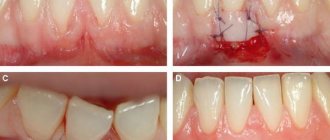Is it possible to treat teeth during pregnancy with pain relief? This is a question that worries many women. Yes, it is possible to treat teeth with anesthesia during pregnancy, both the gynecologist observing the woman and the dentist will agree with this. Anesthesia will relieve a woman from fear and anticipation of pain and, accordingly, from stress, which is very important for a patient in “pregnancy.” However, the use of medications during such a difficult period for the body is carried out with great caution. The doctor must know that the patient is pregnant; this will allow him to select a safe anesthetic that does not threaten the health of the fetus.
Nuances of dental treatment for pregnant women
The period of gestation in itself is not a contraindication to dental treatment. But when visiting a doctor, he must be warned about pregnancy, and also tell the due date. In this case, the following features arise during dental treatment:
- Bleaching is not allowed.
- Local anesthesia is required.
- It is possible to treat caries, pulpitis, periodontitis and gum inflammation.
- Under no circumstances should general anesthesia be used.
- Chemical and photo-curing materials can be used for filling. Polymer lamps do not harm the child.
Advice to expectant mothers - try to treat your teeth and gums before pregnancy or between the 3rd and 6th months of pregnancy, and also review your diet. If you have carious cavities, you will pass on a bouquet of microbes to your unborn child, and the destruction of your own teeth will accelerate several times.
Medvedeva Tatyana Dmitrievna, Pediatric dentist, dental therapist, work experience 19 years
Is lidocaine dangerous during pregnancy?
According to the instructions for the drug, Lidocaine is contraindicated for use while waiting for the baby. However, cases where this drug was used for anesthesia in pregnant women are not so rare. Is the medication really suitable for use during pregnancy?
Lidocaine during early pregnancy
The first trimester of gestation (before the 12th week of pregnancy) is the most dangerous in terms of the use of any medications. The child’s body is just beginning to develop, so chemical compounds can cause irreparable harm to it. The most dangerous period is from 2 to 8 weeks of gestation, because the drug can have a teratogenic effect (provoke deformities, as well as dysfunction of organs and systems). Another danger lies in the threat of increased uterine tone. As a result, there is a threat of spontaneous pregnancy loss. Therefore, the use of lidocaine in the first trimester of pregnancy is strictly prohibited. The only exceptions may be urgent interventions.
Lidocaine during pregnancy in the second trimester
The second trimester of pregnancy is the safest for many interventions. Regarding the use of medications, restrictions on many of them are also becoming less stringent. This is due to the fact that the baby has already formed by this period, so negative effects on his body are practically excluded. Another factor is a decrease in the uterine sensitivity to external influences. The most common reason for using lidocaine during this period is the need for dental intervention. The severe pain that a pregnant woman may experience during treatment or tooth extraction can cause much more harm to the pregnancy than the anesthesia administered. During this period, it is also recommended to carry out other planned interventions, the duration of which does not allow the end of pregnancy.
Lidocaine during pregnancy in the third trimester
The final weeks of waiting for the baby again call into question the possibility of using Lidocaine. During this period, the woman’s body experiences maximum physiological stress. The result of using the drug may be premature onset of labor. At the same time, it is worth taking into account a possible reaction to the drug from the woman’s body - a drop in blood pressure and oxygen starvation of the expectant mother can lead to a slowdown in the baby’s heartbeat and asphyxia. The doctor must constantly monitor the woman’s condition and respond to the slightest changes. If the problem can be postponed for a while, it is better to return to it after the birth of the baby (especially if we are talking not about health, but about aesthetic beauty).
Lidocaine for toothache during pregnancy
Oral health is difficult to underestimate. The pain that occurs at the site of inflammation causes significant discomfort to the woman. No less dangerous is the infection that has accumulated in the affected area. In this case, you should under no circumstances hesitate to contact the dentist. Even if a woman does not experience acute pain, it is strongly recommended to visit a doctor if she has the following conditions:
- Periodically occurring or constant pain in the teeth (even of mild intensity).
- Bleeding gums.
- Increased sensitivity of teeth, manifested in pain when eating hot or cold food (or drinks).
A timely consultation with a dentist will help you adjust your oral care, thereby preventing the need for more radical intervention, incl. and with the use of anesthesia. During pregnancy the following treatment is allowed:
- Caries (resolution of hard dental tissues).
- Stomatitis (inflammation of the mucous tissue lining the oral cavity).
- Gingivitis (inflammation of the marginal surface of the gum).
- Pulpitis (inflammation of the internal tissues of the tooth).
Tooth extraction is allowed only if the latter are painful. An exception is wisdom teeth, because... their extraction is often accompanied by a complicated recovery period. So that tooth pain does not come as a shock and surprise to you, be sure to sanitize your oral cavity at the stage of pregnancy planning.
In dental practice, when treating pregnant patients, Lidocaine is used (if the doctor chose this drug) in the form of a spray (from 1 to 3 doses), as well as in the form of injections. It is worth considering that the area that needs to be numbed with the spray should be small, and the anesthesia time will last about 5 minutes. The medicine can be used no earlier than 16 weeks of gestation. The use of lidocaine during pregnancy for dental treatment in the form of “conduction” anesthesia is strictly not recommended. The dose of the drug is calculated based on the body weight of the pregnant woman. The maximum permissible dosage for an adult is 4.5 mg/kg.
Features of dental treatment at different stages
0-12 weeks. The 1st trimester of pregnancy is very important for the fetus. It is during this period that the baby’s vital organs and placenta are formed. Therefore, the fetus is essentially not protected yet. Serious treatment cannot be carried out at this stage. But the doctor may prescribe topical medications to relieve the inflammatory process. These may be Cholisal, Chlorhexidine, Miramistin.
13-24 weeks. At this time, the placenta has already formed and protects the baby. Therefore, dental treatment and other procedures can be performed.
From the 25th week until birth. At this time, the female body is weakened, and the uterus is very sensitive to the effects of drugs. In addition, a visit to the dentist is often stressful for an expectant mother. Therefore, it is better to wait for treatment procedures until the feeding period. However, this does not apply to cases of acute toothache.
How does lidocaine affect pregnancy and the fetus?
Lidocaine cannot be considered an absolutely safe drug, but panic after a single use of the drug (not earlier than the second trimester) should not be caused either. The main concerns associated with the use of Lidocaine are based on its ability to easily penetrate the placental barrier, and therefore into the baby’s body.
- The use of anesthesia in the first weeks of pregnancy can cause congenital deformities. The use of lidocaine even externally during early pregnancy is strictly not recommended.
- At later stages, it is necessary to be extremely careful if there is a tendency to arterial hypotension. A dangerous decrease in a woman’s blood pressure can lead to oxygen starvation of the baby.
- Exceeding the permissible dosage can lead to the development of bradycardia in a child.
- Using the product after 28 weeks of gestation may cause premature birth. In the last months of pregnancy, a woman’s abdominal organs experience maximum pressure from the uterus, and blood flow may be disrupted. Pressure in the epigastric area often provokes tightness of the thoracic region, and the pregnant woman may experience shortness of breath. The use of Lidocaine can cause difficulty breathing, decreased blood pressure, and muscle spasms. The listed phenomena can seriously disrupt the course of pregnancy and lead to its completion ahead of schedule.
Dental diagnostics during pregnancy
If there is a need to remove a tooth or the patient has been diagnosed with pulpitis, an image cannot be avoided. However, traditional X-rays are contraindicated for pregnant women. After all, the fetus is sensitive to radiation. If an x-ray is necessary, it is best to postpone such a diagnosis to the 2nd trimester. In this case, it is necessary to cover the patient’s abdomen and pelvic area with a lead belt. It minimizes exposure to radiation.
The safest method of dental diagnosis for pregnant women is digital radiovisiography. This technique allows you to reduce the radiation load by 90% compared to conventional x-rays.
Procedure for tooth extraction:
- anesthesia;
- detachment of the gums from the dental crown;
- grasping the crown with special forceps;
- gentle movements back and forth to loosen;
- removal of the lower or upper tooth;
- treatment of the wound, suturing if necessary.
After the operation, it is necessary to monitor the patient’s condition for at least half an hour - periodically check blood pressure and pulse rate. Then give the necessary recommendations and release. It is advisable that she does not drive on this day, and that she has someone accompanying her.
If the tooth is open, removal may be avoided. Prescribe rinsing with solutions to liquefy and remove pus. If the channels are more or less passable, this can help relieve pain for a while. The pain occurs due to the pressure formed by the pus due to inflammation on the surrounding tissue. Once the outflow is created, the pain will subside almost immediately.
But, as mentioned above, only a doctor, after carefully weighing all factors, decides to remove or postpone. Therefore, in any case, you need to contact a specialist. If you take any independent actions, they can worsen the situation even further. It is better not to take risks due to fear of visiting the dentist.
Features of anesthesia for pregnant women
During pregnancy, drugs that have minimal effects on blood vessels are used for pain relief. They also cannot cross the placenta and affect the baby.
Lidocaine is contraindicated during pregnancy. It can cause a sharp decrease in blood pressure, cramps and weakness.
Today, the best anesthesia option for pregnant women remains drugs based on anticain:
- Ultracaine.
- Altrifryn.
- Ubistezin.
- Alfacaine.
The listed drugs do not constrict blood vessels, which would be harmful for the expectant mother. They also have a local effect, so they do not affect the baby.
Contraindications to the use of Lidocaine (spray, injection) during pregnancy
Before using any drug, the doctor should check with the woman for possible contraindications. For Lidocaine, this list is as follows:
- Individual hypersensitivity reaction.
- Low blood pressure.
- Pathologies of the liver and/or kidneys.
- Disturbances in the functioning of the cardiovascular system.
Lidocaine during pregnancy - reviews of the drug
Despite the restrictions on the use of Lidocaine during pregnancy, many doctors still use this drug for anesthesia during various medical procedures. The experience of most women who have already given birth is based on a single administration of the drug. No negative phenomena were noted, the children were born on time and without developmental deviations. A number of women noted that the drug was prescribed as part of an antibacterial “cocktail” in the second half of pregnancy. There were also no significant negative consequences noted.
To summarize, it is worth noting that despite the warnings of the drug manufacturers, the drug still finds use in such a category of patients as pregnant women. It is difficult to answer for sure whether Lidocaine is harmful during pregnancy. While there are potential risks from exposure of the drug to the baby in the womb, there is no statistical data regarding a higher number of complicated pregnancies after a single use of Lidocaine. The drug is a drug of last resort, so you should not use it unless absolutely necessary, especially since the modern pharmaceutical market can offer safer alternatives (for example, Ultracaine).
Tooth extraction during pregnancy
Tooth extraction is a good reason for stress. During pregnancy it is strictly contraindicated. Therefore, the decision to remove a tooth is made only in extreme cases:
- The presence of a cyst more than 1 centimeter in diameter.
- Fracture of the root or crown.
- Acute pain that cannot be relieved in any other way.
- A deep focus of caries, which is a source of suppuration.
Wisdom teeth should never be removed in pregnant women. After all, after such an operation the socket often becomes inflamed. Stopping this process requires taking antibiotics. This, in turn, is extremely undesirable for the mother and fetus.
Lidocaine spray for local use. dosed 4.6mg/dose 38g
Registration Certificate Holder
SYNTHESIS (Russia)
Dosage form
Medicine - Lidocaine-Akos
Description
Spray for local and external use
in the form of a transparent, colorless or yellowish liquid.
1 dose
lidocaine hydrochloride monohydrate 4.6 mg
Excipients
: ethanol 96% (rectified ethyl alcohol, “Extra” grade) - 18.4 mg, propylene glycol - 4.6 mg, sodium hydroxide - 0.23 mg, sodium saccharinate dihydrate (sodium saccharin) - 0.138 mg, racementol (racemic menthol) - 0.092 mg, water purified - up to 0.046 g.
340 doses - plastic bottles with a spray nozzle (1) - cardboard packs. 650 doses - plastic bottles with a spray nozzle (1) - cardboard packs.
Indications
For terminal (superficial) anesthesia of mucous membranes: in dentistry, in otorhinolaryngology, in obstetrics and gynecology, for instrumental and endoscopic examinations, in surgery and dermatology, radiographic examination (elimination of nausea and pharyngeal reflex).
Contraindications for use
Use for tonsillectomy and adenotomy in children under 8 years of age;
hypersensitivity to lidocaine. With caution
during instrumental studies (rectoscopy) in patients with hemorrhoidal bleeding, local infection in the area of application, trauma to the mucous membrane or skin in the area of application, severe somatic pathology, epilepsy, bradycardia, cardiac conduction disorders, impaired liver function, severe shock, young children, elderly patients, during pregnancy and lactation.
pharmachologic effect
Local anesthetic for superficial anesthesia. The action is due to the blockade of voltage-dependent sodium channels, which prevents the generation of impulses at the endings of sensory nerves and the conduction of pain impulses along nerve fibers.
When applied topically, it dilates blood vessels and does not have a local irritating effect. Has an analgesic effect.
The effect develops 1-5 minutes after application to mucous membranes or skin and lasts 30-60 minutes.
Drug interactions
Cimetidine and propranolol reduce the hepatic clearance of lidocaine (decreased metabolism due to inhibition of microsomal oxidation and decreased hepatic blood flow) and increase the risk of toxic effects (including stunned state, drowsiness, bradycardia, paresthesia).
Barbiturates, phenytoin, rifampicin (inducers of microsomal liver enzymes) reduce effectiveness (an increase in dose may be required).
When prescribed with ajmaline, phenytoin, verapamil, quinidine, amiodarone, the negative inotropic effect may be enhanced. Co-administration with beta-blockers increases the risk of bradycardia.
Curare-like drugs enhance muscle relaxation.
Procainamide increases the risk of developing central nervous system excitation and hallucinations.
With the simultaneous administration of lidocaine and hypnotics and sedatives, their inhibitory effect on the central nervous system may be enhanced.
With intravenous administration of hexobarbital or sodium thiopental against the background of the action of lidocaine, respiratory depression is possible.
Under the influence of MAO inhibitors, the local anesthetic effect of lidocaine may be enhanced.
With the simultaneous use of lidocaine and polymyxin B, an increased inhibitory effect on neuromuscular transmission is possible, so in this case it is necessary to monitor the patient's respiratory function.
Dosage regimen
Apply locally, externally. The dose depends on the indications and the area of the anesthetized surface.
Side effect
Local reactions:
a slight tingling sensation that disappears as the anesthetic effect develops (within 1 minute); Transient erythema, swelling and sensory disturbances may occur.
Allergic reactions:
very rarely - urticaria, angioedema, bronchospasm; in exceptional cases - anaphylactic shock. The use of the drug should be stopped immediately if any allergic reaction occurs.
After topical application, systemic effects rarely develop, because
Only a very small amount of the active substance can enter the bloodstream. From the side of the central nervous system:
very rarely - nervous excitement, systemic dizziness, insomnia, loss of consciousness and respiratory paralysis.
From the cardiovascular system:
decreased blood pressure, depression of myocardial function, bradycardia, cardiac arrest.
special instructions
Use with caution in patients with epilepsy, as well as bradycardia, cardiac conduction disturbances, impaired liver function and severe shock, especially when significant amounts of the drug can be expected to be absorbed when large areas of tissue are treated with high doses.
It is important to prevent lidocaine from entering the respiratory tract (risk of aspiration).
Application to the buccal mucosa is associated with a risk of dysphagia and subsequent aspiration, especially in children. If the sensitivity of the tongue and mucous membrane of the cheeks is impaired, the risk of biting them increases.
Lidocaine is well absorbed through mucous membranes (especially in the trachea) and damaged skin. This should be taken into account, especially when treating large areas of tissue in children.
In cases of use during surgical operations in the pharynx or nasopharynx, it should be taken into account that lidocaine, suppressing the pharyngeal reflex, enters the larynx and trachea and suppresses the cough reflex, which can lead to bronchopneumonia. This is especially important in children, as they are more likely to trigger their swallowing reflex. In this regard, the spray is not recommended for local anesthesia before tonsillectomy and adenotomy in children under 8 years of age.
Caution should be exercised when applying lidocaine to damaged mucous membranes and/or infected areas.
Lower doses should be used in weakened and elderly patients, in acute diseases, as well as in children - in accordance with age and general condition.
Effect on the ability to drive vehicles and machinery
During the treatment period, care must be taken when driving vehicles and engaging in other potentially hazardous activities that require increased concentration and speed of psychomotor reactions.
Use during pregnancy and breastfeeding
Restrictions during pregnancy - With caution. Restrictions when breastfeeding - With caution.
If local anesthesia is necessary and no safer treatment is available, lidocaine can be used during pregnancy.
Lidocaine is excreted in breast milk, but after topical use in normal therapeutic doses, the amount excreted in milk is too small to cause any harm to a nursing infant.
Use for renal impairment
Restrictions for impaired renal function - With caution.
In chronic renal failure, accumulation of metabolites is possible.
Use for liver dysfunction
Restrictions for liver dysfunction - With caution. The drug should be used with caution if liver function is impaired.
Use in elderly patients
Restrictions for elderly patients - Use with caution.
Use with caution in elderly patients.
Use in children
Restrictions for children - Use with caution. Use with caution in children. Use for local anesthesia before tonsillectomy and adenotomy in children under 8 years of age is not recommended.









